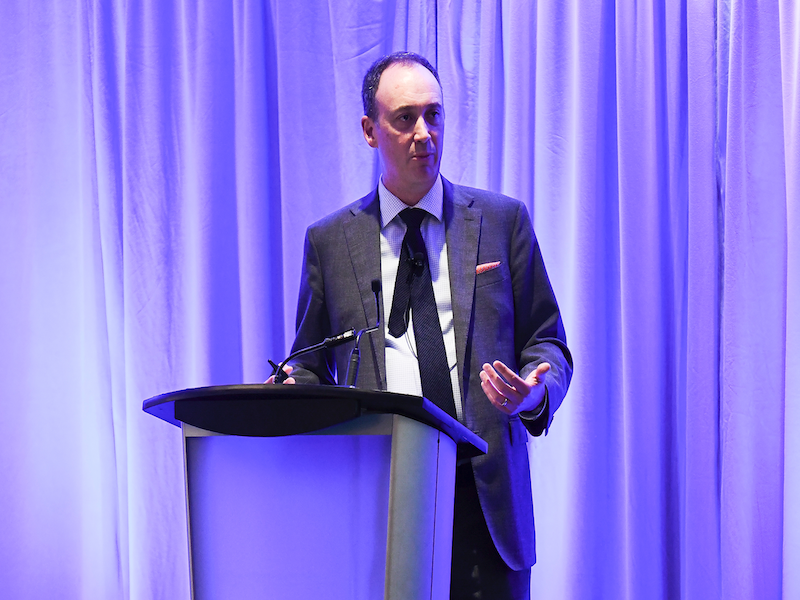

In volatile market environments, adding real assets to defined contribution pension plan portfolios has the ability to provide diversification benefits and give members a “much smoother ride” to retirement, according to Andrew Knox, managing director of the Franklin global real asset fund at Franklin Templeton Investments.
Speaking during Benefits Canada’s 2023 DC Investment Forum in late September, he said real assets — which include commercial real estate, infrastructure and natural resources — offer investors a handful of benefits. They tend to to rise in value with inflation and add a level of protection to the portfolio, while also tending to grow alongside economic activity, creating a consistent return in line with the returns of a traditional 60-40 balanced portfolio over the long-term.
Read: 2022 GIC coverage: Unpacking challenges, misunderstandings around private market allocations
However, Knox also highlighted the multiple challenges presented by the real asset space. For one, private markets don’t have investable indexes, “so it’s impossible to be a passive investor” and it’s important for DC plan sponsors to select strong managers. It’s also difficult to benchmark managers’ performance given the lack of investable benchmarks and challenging to understand what risk level is enough, as real asset managers take different strategies.
In real estate, for example, core strategies tend to involve investing in assets that are fully developed, operational and fully leased for a long time frame to quality tenants, providing stable income and low price volatility, he noted. Value-add strategies, on the other hand, typically involve looking for fixer-upper assets that investors can overhaul and bring up to core standard, thereby increasing the value. And opportunistic strategies tend to involve buying raw land and developing a project on it.
Knox also suggested DC plan sponsors consider whether they want broad-based, sector- or geography-specific or even thematic exposure to real assets. “It can be difficult for even the average allocator to make sure they build a portfolio that’s properly diversified and achieves their goals over the long term.”
Franklin Templeton is currently having conversations with multiple DC plan sponsors looking to add real asset funds to their member choice option and a common question is how much exposure is enough, he said. The firm’s own pension plan considered this question and “the answer that we came back with was, at the maximum level, any one investor should invest in their portfolio . . . around 25 per cent,” a percentage that’s consistent with what larger plans are doing.
Read: Revamping, retuning investment allocations at the ATCO’s pension plans
While many DC plan sponsors typically begin investing in real assets with Canadian assets and expanding outwards, Knox advocated for a global approach. The Canadian real asset market is “very narrow and it’s very simplistic,” he said, with much of it controlled by the major pension plans, record keepers and some family offices and high-net-worth individuals.
Much of the Canadian real asset market is also weighted toward infrastructure assets, but many of the companies that control those assets — such as Canadian Pacific Railway, TC Energy Corp. or Enbridge Inc. — are a major part of the S&P TSX index. However, going global also means dealing with different regulations and tax regimes, he warned.
Knox also suggested plan sponsors keep sustainability in mind when exploring real assets. Within 10 to 15 years, carbon-intensive assets will likely be worth far less, while there are plenty of opportunities within real estate, infrastructure and natural resources space to take advantage of climate change mitigation trends.
When deciding which approach to take, he cautioned that listed markets and private open-end and closed-end funds have significantly different risk-return characteristics. While listed markets are very quick to implement and easy to rebalance, addressing capital accumulation plans’ need for liquidity, their returns are highly correlated to that of equities and lack diversification benefits.
Read: Balancing liquidity and the search for yield at U.S. public pension funds
Meanwhile, private open-end funds tend to have higher minimum transactions of more than $1 million and the time to implement a trade can take between three months and two years, said Knox, noting there isn’t typically any daily liquidity and net asset values are stuck at either monthly or quarterly, a significant challenge for CAP plans. However, the volatility tends to be quite low, the returns moderate and the diversification benefits “very, very strong.”
Further up the risk spectrum, private closed-end funds have even higher minimum transactions, he added, and plan sponsors will face significant restrictions in getting their cash out of the fund. It also takes longer for their capital to be deployed. “The design makes it impossible to rebalance the portfolio and the hidden costs tend to be quite complex in the space.”
However, the benefits are magnified: these funds tend to generate long-term return expectations of 10 per cent to 15 per cent with low volatility and significant diversification benefits.
Knox said the optimal solution for the DC space is a blend of listed markets and open-end funds with perhaps a sliver of private closed-end funds, which ensures plan sponsors have the ability to rebalance and strike a daily net asset value, pay out retirement benefits and maintain moderate risk-return characteristics while diversifying the portfolio.
Read more coverage of the 2023 DC Investment Forum.
